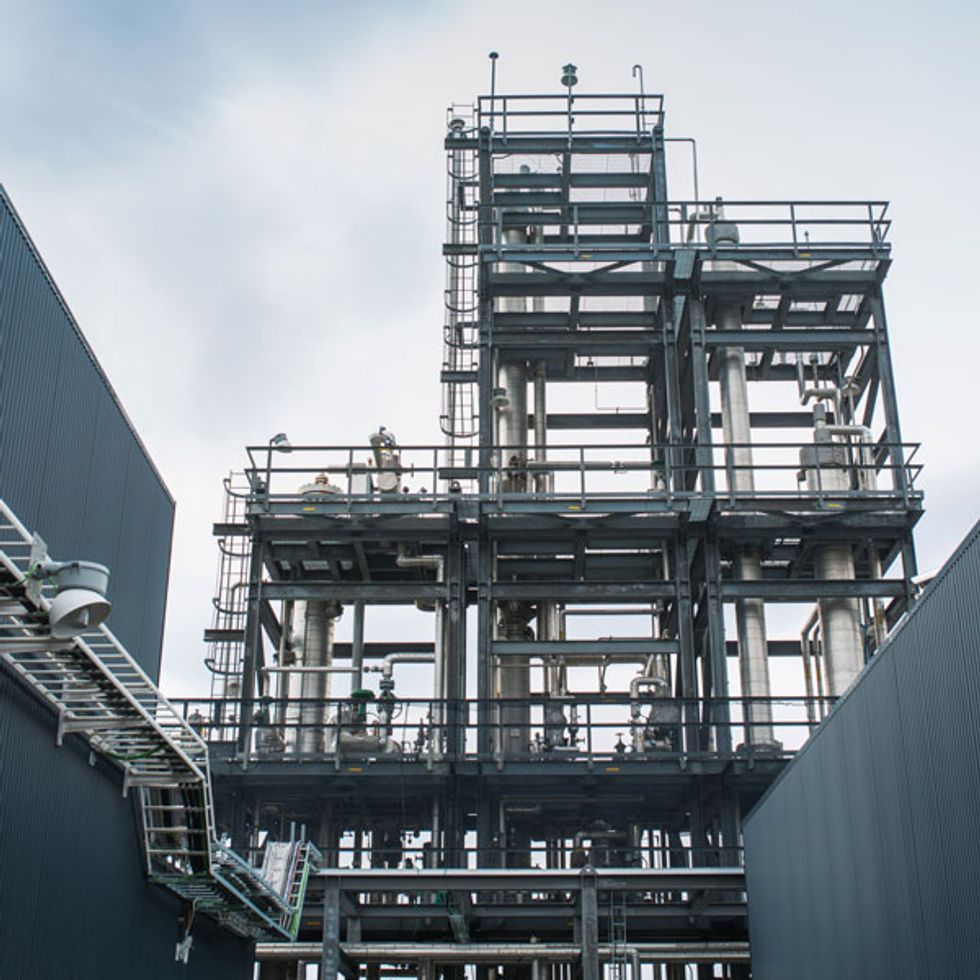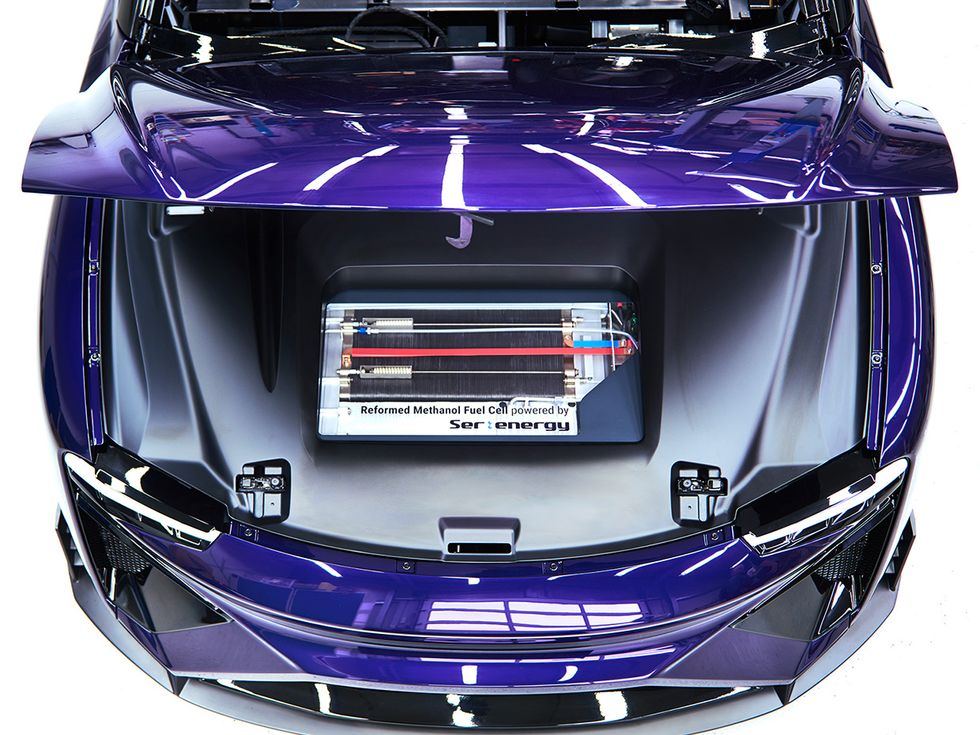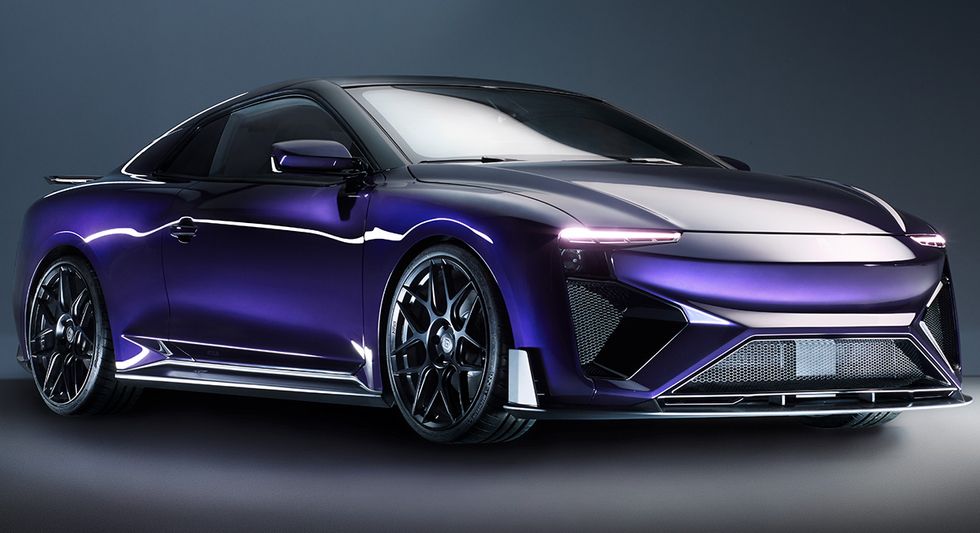Methanol-Fueled Cars Could Drive Us Toward an Emissionless Future
Icelandic firm Carbon Recycling International is turning industrial pollution into a low-carbon fuel for cars, trucks, and ships

Jump to Articles in this Section
Just off a two-lane highway that winds through the black volcanic rock fields of southwest Iceland sits a nondescript industrial plant. Its multistoried network of pipes and tubes reveal little about what goes on there. Each year hundreds of thousands of tourists pass right by, on their way to visit the strange and beautiful Blue Lagoon, an outdoor spa whose steaming milky blue water flows directly from the nearby Svartsengi geothermal power station. If tourists notice the plant at all, it’s maybe to wonder why it’s here.
As it happens, this plant also depends on the Svartsengi facility, not for its silica-infused water but for its carbon dioxide. And what’s going on inside the plant has the potential to dramatically decarbonize the transportation sector. The plant belongs to Carbon Recycling International (CRI), whose engineers have developed a novel method of using renewable energy to produce methanol fuel from waste streams of CO2 and electrolyzed water. Methanol generated this way, CRI is betting, could have a real impact on climate change.

Over the past decade, CRI engineers have been refining and vetting their process at the plant, which is named for the late Nobel Prize–winning chemist George A. Olah. A pipeline carries about 5,500 metric tons of CO2 per year from Svartsengi, which also supplies the electricity to split water into hydrogen and oxygen. The hydrogen and CO2 are then combined to form water-laden methanol, which is distilled into pure methanol. Opened in 2012, the plant now produces 4,000 metric tons, or 5 million liters, a year. Some of the fuel, which CRI has dubbed Vulcanol, is used to operate a test fleet of methanol-burning sedans built by the Chinese car giant Geely Auto Group. The carmaker’s founder, billionaire Li Shufu, has been pushing methanol transportation in his country. Geely has a factory in Shanxi province that can produce up to 100,000 methanol cars a year and is constructing another factory in Guizhou province.
Of course, in an ideal low-carbon world, the roads would be filled not with methanol cars but with electric vehicles charged by renewable energy. We’re still well short of that goal, however. Today, EVs make up a tiny fraction of cars in every country where they’re sold. Even under the most optimistic assumptions, it may be midcentury before a majority of cars on the road are all-electric.
In the meantime, methanol is among the most promising alternatives for significantly shrinking our cars’ carbon footprint. If you power a methanol plant with a renewable energy source and capture the CO2 coming from the exhaust of, say, a steel plant, you can halve the total carbon being released into the atmosphere. So even though burning methanol in a car’s internal combustion engine does release CO2, along with some water vapor, you’re first capturing CO2 from the steel plant. That is, you’re basically recycling the carbon and extracting some useful work before it gets released. In contrast to carbon capture and storage, which aims to permanently sequester CO2 deep underground, this type of cycle is known as “carbon capture and utilization.”
“Many people are convinced that EVs will solve our climate problem,” says G.K. Surya Prakash, a professor of chemistry at the University of Southern California and a longtime collaborator of Olah’s. “But the technology isn’t there yet, the batteries aren’t there yet. And many third-world countries don’t have enough electricity even for basic needs, so what’s all this talk about EVs?” Methanol, by contrast, is doable right now, he says. The simple alcohol can be burned in an internal combustion engine, and it can be stored, transported, and distributed using the same basic infrastructure that’s now used for gasoline and diesel.
“That’s the beauty of methanol,” says Prakash. “You don’t have to build an entirely new infrastructure from scratch.”
If the idea of methanol cars sounds vaguely familiar, that may be because it’s not new. Back in the 1980s, such vehicles were heavily promoted by the government of California, as a way to address the state’s air pollution as well as its dependence on foreign oil. Ford Motor Co. spearheaded the development of a flex-fuel car, which could burn gasoline as well as alternative fuels like methanol. California’s fleet of methanol vehicles eventually reached 15,000. But falling oil prices and the U.S. corn lobby’s push for ethanol ultimately killed the methanol car.
This time around is different, says Paul Wuebben. He was one of the leaders of California’s methanol experiment and now serves as CRI’s senior director of fuel applications. (Wuebben’s colleagues call him “Mr. Methanol,” a nickname that makes him both slightly embarrassed and rather proud.) “Methanol is coming back strongly,” he says.

The European Union, India, and Israel are all investing in methanol transportation, Wuebben notes. And in China, methanol accounts for 8 percent of transportation fuel, and the market research firm IHS Markit is projecting demand to grow by 7 percent per year. The availability of methanol-gasoline blends there ranges from 5 percent methanol (M5) to 100 percent (M100). While most of China’s methanol is produced from coal or using coal power, Geely’s Li recently called for the creation of a “liquid sunshine economy,” in which the fuel’s production would be solar powered. And in April, the Chinese car startup AIWays, working with the German car engineer Roland Gumpert and the Danish fuel cell company SerEnergy, unveiled a methanol fuel cell sports car at the Beijing Motor Show.
And Iceland’s CRI is riding the methanol wave. At the company’s headquarters in Kópavogur, just outside Reykjavík, Benedikt Stefánsson, the business development director, says it’s been quite a ride. CRI was founded by two Icelanders and two Americans in 2006, the same year that Olah, Prakash, and Alain Goeppert published Beyond Oil and Gas: The Methanol Economy(Wiley), laying out a grand vision for weaning the world from its habit of consuming some 97 million barrels of oil a day. The following year, CRI opened a small pilot plant. But the global financial crisis of 2008–2009 hit Iceland particularly hard, and investment funding dried up. CRI cobbled together enough money from local investors and family members to complete the Olah plant in 2012. Subsequent investments from Canadian methanol producer Methenex and Geely allowed the company to expand the plant and start developing projects outside Iceland.

Smil Says…
Current and planned projects have an annual capacity equal to just 0.3 percent of annual emissions from stationary sources.
Click here for Vaclav Smil”s commentary on the entire Blueprints for a Miracle special report.
Stefánsson says the right way to view a methanol-fueled car is as a replacement for a traditional gasoline- or diesel-powered car, for the vast majority of consumers who aren’t ready to make the leap to a fully electric car. In Iceland, he notes, government incentives favoring EVs have led to a recent uptick in battery electric vehicles and plug-in hybrids. Nevertheless, he says, Iceland’s cold climate exacerbates the vehicles’ already limited electric range. So owners of hybrids still find themselves pulling up to the pump regularly.
Of course, even if methanol fuel is similar to gasoline in many respects, it’s not exactly the same. For starters, methanol’s energy content is about half that of gasoline, so an M100 car has to be filled up twice as often. “Methanol is a unique product, so you have to handle it in parallel with gasoline,” says Daniel Sperling, director of the Institute of Transportation Studies at the University of California, Davis. He’s highly skeptical that methanol cars will ever expand beyond their current niche.
“The auto industry is investing tens of billions of dollars in electric drive technology,” Sperling says. “They don’t need or want another product.”
For different reasons, Edward S. Rubin, a professor of engineering and public policy at Carnegie Mellon University, in Pittsburgh, also doubts methanol’s prospects. In a recent paper, he and several collaborators examined the extent to which converting CO2 to fuels—as CRI is doing—could mitigate climate change. Their conclusion: “While CCU [carbon capture and utilization] does have the potential to mitigate some CO2 emissions (provided that a continuous supply of carbon-free electricity is available), an alternative system employing CCS [carbon capture and storage] together with the same carbon-free electricity is a far more effective mitigation option.”
“If your chief goal is to solve the climate problem, methanol isn’t the best way to do it,” Rubin says. Climate models suggest that to stave off the worst effects of a changing climate, the electricity grid and other industrial sectors need to be deeply decarbonized by midcentury, he says. CCU may be more attractive than CCS because you may be able to make money doing it, he notes, but it also prolongs the time it will take to bring down greenhouse gas emissions to the levels needed to avoid dangerous impacts. “The timescale of climate-change mitigation means we really can’t afford to wait.”
Stefánsson agrees with this sense of urgency but argues that any scheme to mitigate climate change should include liquid fuels from CO2. “In any scenario, we need rapidly increasing investment in carbon capture,” he says. “But CCS has zero impact on the use of fossil fuels in transport. It is also a perpetual cost, which is why adoption has been so slow.” And there’s still no good near-term technology for electrifying long-distance and heavy-goods transport or shipping or aviation, he adds.
“Right now, the world is still flush with fossil fuel resources,” says USC’s Prakash. Absent a strong system of rewards and penalties that discourages the use of those resources, people will use them. Methanol offers a bridge from our highly carbonated present to a low-carbon future, in which electricity comes from renewables or nuclear and cars are electric. In the meantime, Prakash says, methanol can help. Rather than wastefully flaring natural gas in the Bakken Formation, for instance, why not place a methanol plant there and produce fuel? Rather than curtailing wind and solar when the power grid can’t absorb their output, why not use the excess for methanol?
“Methanol gives us a way to store not just kilowatt- or megawatt-hours of power but gigawatt-hours,” Prakash says. “It could be a game changer.”
This article appears in the June 2018 print issue as “Turning Pollution Into Fuel.”
